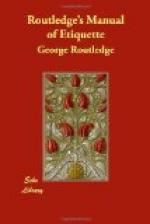The step, although easy to learn, requires great precision. We would recommend our readers to adhere throughout to the circular movement. Some dancers begin by four steps to the right, then back again, not turning until they commence the second half of the figure. But when many couples are dancing this practice involves a risk of collisions, and it is safer to begin at once with the figure en tournant. The second part of the step consists of a series of slight hops, which must be made exactly at the same moment by both parties, otherwise a break-down is inevitable. They should be executed as quickly as possible, so as to avoid the jigging effect which bad dancers impart to the Schottische. When well performed it is a very animated and elegant dance, forming an agreeable variety to the Polka and Valse.
The time is 2/4; it should be played a good deal slower than the Polka; when hurried it becomes ungraceful and vulgar. The first and third beat in each bar should be slightly marked.
We proceed to describe the step as danced by the gentleman.
Slide the left foot forward; bring right foot close up behind left foot. Slide left foot forward a second time. Spring upon left foot. Then do the same with right foot.
Having completed four steps, first with the left foot, and then with the right, you come to the second part, which consists of a series of double hops, two on each foot alternately. Hop twice on the left foot (one hop for each beat of the time), and half turn round; then twice on the right, completing the circular movement. Repeat the same through another four beats; then resume first step through the next two bars, and continue to alternate them every second bar. You can also vary the dance at pleasure, by continuing the first step without changing it for the hops; or you can likewise continue these throughout several bars in succession; taking care, of course, to apprise your partner of your intention. Even when well and quietly danced, there is something undignified in the hopping movement of the second step; and we have observed with satisfaction that for some time past it has been replaced by the step of the Valse a Deux Temps, which is now generally used instead of the double hops.
* * * * *
XV.—LA VARSOVIENNE.
This is a round dance for two, which, like the Polka Mazourka, is a combination of the steps of one or two other dances. Since the introduction of the Polka and the Cellarius, several dances have been invented which partake largely of the character of both. La Varsovienne is very graceful, and was popular in England a few years ago. It is not often danced now.
Take your partner as for the Valse. Count three in each bar. Time much the same as in Polka Mazourka. The music is generally divided into parts of sixteen bars each. The steps for the gentleman is as follows in the first part:—




